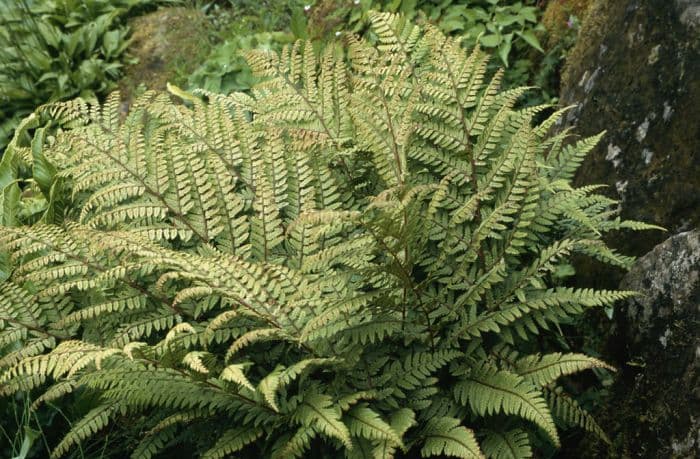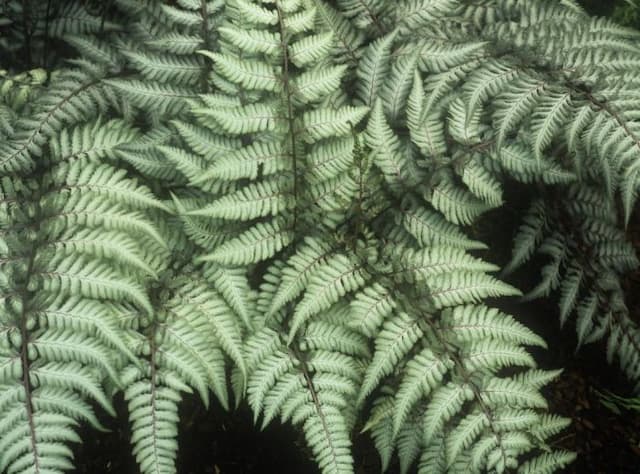Eared Lady Fern Athyrium otophorum

ABOUT
Athyrium otophorum, commonly known as eared lady fern, is a distinctive fern with visually appealing fronds that have a delicate and lace-like appearance. The leaves are typically light green, sometimes with a hint of silver-blue, presenting a soft and frosted look. Each frond is made up of several small, individual leaflets, which have gentle and rounded lobes, giving them an almost feathery texture. The stems, which hold the fronds, show off a rich reddish or purplish hue, adding a striking contrast to the plant's overall appearance. The leaflets are often arranged in an alternate pattern along the stem, creating a sense of rhythm and visual interest. Overall, the eared lady fern is well-loved for its graceful form and the subtle beauty it brings to shade gardens and woodland settings.
About this plant
 Names
NamesFamily
Athyriaceae
Synonyms
Eared Lady Fern, Auriculate Lady Fern
Common names
Athyrium otophorum var. okanum, Athyrium otophorum var. lanceum.
 Toxicity
ToxicityTo humans
Athyrium otophorum, commonly known as the eared lady fern, is not widely recognized as a toxic plant to humans. There is limited information available on its toxicity; hence, it is generally considered non-toxic. No symptoms of poisoning are commonly reported upon ingestion of this fern. However, as with consumption of any non-culinary plants, it is advised to be cautious and avoid eating plants not specifically identified as safe for human consumption.
To pets
Eared lady fern, the common name for Athyrium otophorum, is not known to be toxic to pets. There are no well-documented symptoms of poisoning in pets such as cats and dogs from ingestion of this plant. It is generally considered safe, but it is always best to prevent pets from eating ornamental plants as they can sometimes cause mild stomach upset or irritation due to the plant's natural defense mechanisms, even if they are not known for being poisonous.
 Characteristics
CharacteristicsLife cycle
Perennials
Foliage type
Deciduous
Color of leaves
Varies
Height
1-2 feet (30-60 cm)
Spread
1-2 feet (30-60 cm)
Plant type
Fern
Hardiness zones
5
Native area
East Asia
Benefits
 General Benefits
General Benefits- Ecosystem Support: Provides habitat and food for insects and wildlife.
- Ornamental Value: Adds aesthetic appeal to gardens with its unique foliage.
- Soil Improvement: Helps with soil stabilization and prevents erosion.
- Shade Tolerance: Thrives in shaded areas where other plants might struggle.
- Low Maintenance: Requires minimal care once established, making it a good choice for low-effort landscaping.
- Drought Resistance: Can survive in dry conditions after becoming established.
- Biodiversity: Adds to the plant variety in a garden or natural setting, supporting overall biodiversity.
 Medical Properties
Medical PropertiesThis plant is not used for medical purposes.
 Air-purifying Qualities
Air-purifying QualitiesThis plant is not specifically known for air purifying qualities.
 Other Uses
Other Uses- Athyrium otophorum, commonly known as eared lady fern, can be used as a natural dye source, providing subtle colors to textiles when treated properly.
- In floral arrangements, the delicate fronds of eared lady fern add texture and a sense of woodland charm to bouquets and centerpieces.
- Eared lady ferns can be planted in outdoor fairy gardens to create a lush, miniature forested setting that enhances the magical ambiance.
- This plant may be used in terrariums, as its moderate size and humidity tolerance makes it suitable for enclosed environments.
- Eared lady ferns can be utilized in garden design to create a tapestry of foliage when planted alongside other shade-tolerant plants.
- Eared lady ferns can serve as a living mulch, covering the ground beneath taller plants to help maintain soil moisture and suppress weeds.
- In craft projects, the fronds can be pressed and used to create botanical prints or patterns on fabrics and papers.
- Eared lady ferns can be used in educational settings to teach children about plant growth and fern reproduction through their spore life cycle.
- For photographers and artists, the intricate fronds and patterns of eared lady fern provide interesting subjects for nature-inspired artwork and macro photography.
- In colder regions, eared lady ferns can be grown as annuals to add greenery to summer gardens, even if they cannot survive the winter.
Interesting Facts
 Feng Shui
Feng ShuiThe Athyrium otophorum, commonly known as Eared Lady Fern, is not used in Feng Shui practice.
 Zodiac Sign Compitability
Zodiac Sign CompitabilityThe Eared Lady Fern is not used in astrology practice.
 Plant Symbolism
Plant Symbolism- Delicacy: Also known as the Eared Lady Fern, Athyrium otophorum is revered for its graceful and delicate fronds, symbolizing a gentle nature or fine aesthetic sensibilities.
- Femininity: The Eared Lady Fern, with its elegant structure and soft appearance, often represents femininity and the traditional qualities associated with it such as gentleness, sensitivity, and nurturing.
- Solitude: As ferns thrive in shaded and secluded areas, they can symbolize solitude, privacy, or the enjoyment of peaceful moments alone.
- Endurance: Ferns are prehistoric plants that have survived countless years and conditions, making them symbols of endurance, resilience, and the ability to withstand challenges.
- Secret Bond: In the Victorian language of flowers, ferns were used to communicate secret bonds of love or friendship, sharing this message without words.
- Protection: Ferns are often associated with protective qualities due to their lush, shielding fronds, which can symbolize shelter and safety.
 Water
WaterThe Eared Lady Fern, commonly known as Athyrium otophorum, prefers consistently moist soil. It should be watered thoroughly once the top inch of soil feels dry to the touch. Generally, this means watering the fern every 7 to 10 days, but the frequency may vary depending on the humidity and temperature of your environment. When watering, use room-temperature water and aim to apply about half a gallon per watering session for an average-sized plant, making sure to avoid waterlogging the soil. It's vital to provide enough water to reach the roots, but let any excess drain away to prevent root rot.
 Light
LightEared Lady Fern thrives in partial to full shade conditions, making it well-suited for a spot that receives indirect light or is shaded for part of the day. Avoid direct sunlight, as this can scorch the delicate fronds. The ideal location is a north-facing window or a shady area of a room with east or west exposure to ensure the plant receives gentle, filtered light without harsh sunbeams.
 Temperature
TemperatureEared Lady Fern grows best in temperatures ranging from 60 to 75 degrees Fahrenheit. While it can tolerate a brief period of colder weather, prolonged exposure to temperatures below 50 degrees Fahrenheit can harm the plant. Similarly, avoid placing it in locations where the temperature exceeds 80 degrees Fahrenheit to prevent heat stress and dehydration of the fern.
 Pruning
PruningPruning the Eared Lady Fern is generally done to remove any brown or damaged fronds, which allows the plant to direct energy into new growth. It's best to prune in spring just before new fronds unfurl, snipping off the old fronds at the base. Aside from aesthetic reasons, pruning is also a way to manage the plant's size and shape. Regular pruning once a year is often enough to maintain a healthy and attractive fern.
 Cleaning
CleaningAs needed
 Soil
SoilThe eared lady fern (Athyrium otophorum) thrives in moist, well-draining soil enriched with organic matter, such as a mix of garden soil, peat, and perlite. The ideal pH for this fern is slightly acidic to neutral, ranging from 6.0 to 7.0.
 Repotting
RepottingEared lady ferns generally require repotting every two to three years or when the roots start to crowd the container to ensure they continue to grow healthily.
 Humidity & Misting
Humidity & MistingEared lady fern prefers high humidity levels, ideally between 60% to 80%, to maintain its lush, green foliage.
 Suitable locations
Suitable locationsIndoor
Place in bright, indirect light with high humidity for eared lady fern.
Outdoor
Plant in part shade, moist soil, protect from harsh sun for eared lady fern.
Hardiness zone
4-8 USDA
 Life cycle
Life cycleEared Lady Fern (Athyrium otophorum) begins its life as a spore, which germinates in moist conditions to develop into a tiny, heart-shaped gametophyte. The gametophyte houses both the male and female reproductive structures; when mature, it facilitates fertilization to form a zygote. The zygote then develops into a sporophyte, the familiar fern plant with fronds. The fronds unfurl in a fiddlehead or crozier shape and gradually expand as they mature. As an adult plant, the Eared Lady Fern produces spores on the underside of its fronds, completing the reproductive cycle. This plant goes through phases of vegetative growth, reproduction, spore dispersal, and dormancy, typically in relation to the seasonal climate it inhabits.
 Propogation
PropogationPropogation time
Spring-summer
For Athyrium otophorum, commonly known as eared lady fern, the most popular propagation method is by spores, which is typically done in late summer after the spores have matured. The process involves collecting ripe spores from the underside of the fronds when they are a dark brown color. These spores are then sown on the surface of a sterilized peat-based or fine-grade fern compost in a container, which should be kept in a shaded area and at a consistent temperature of about 70°F (approximately 21°C). The surface of the compost should be kept moist but not waterlogged, and the container must be covered with a piece of glass or clear plastic to maintain humidity. Germination may take a few weeks to a few months, and once the sporelings are large enough to handle, they can be transferred to individual pots. Careful monitoring for moisture and temperature is crucial throughout this process.




